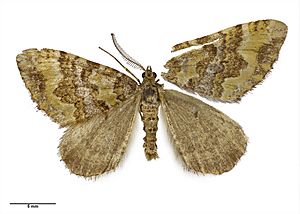Asaphodes glaciata facts for kids
Quick facts for kids Asaphodes glaciata |
|
|---|---|
 |
|
| Male | |
| Scientific classification | |
| Synonyms | |
|
Asaphodes glaciata is a type of moth that belongs to the Geometridae family. This special moth lives only in New Zealand. It has been found only in the Westland area, specifically near the Fox and Franz Josef Glaciers.
Contents
Discovering the Glacier Moth
This moth was first described in 1925 by a scientist named George Hudson. He originally named it Xanthorhoe glaciata. The moth specimens he used were collected by Charles E. Clarke. They were found on Mount Moltke in Westland during January, at a high altitude of 1700 meters.
George Hudson also wrote about and showed pictures of this moth in his 1928 book. The book was called The Butterflies and Moths of New Zealand.
Later, in 1987, another scientist named Robin C. Craw suggested that this moth should be placed in a different group, the Asaphodes genus. John S. Dugdale agreed with this idea in 1988. The original specimen, called a holotype, is kept at the Auckland War Memorial Museum.
What the Glacier Moth Looks Like
This moth has wings that are about 3 centimeters (1.25 inches) wide. Its front wings are a bright yellow-brown color. They have dark brown and bluish-white patterns.
The wings also have a small bluish-white patch near the body. There are also wavy lines of dark brown scales. The hindwings are a pale brownish-yellow with a wide, grayish band at the edge. They also have many thin, broken gray lines and dots.
Where the Glacier Moth Lives
This moth is endemic to New Zealand. This means it is found nowhere else in the world. Asaphodes glaciata can only be found in the Westland region. Specifically, it lives around the Fox Glacier and Franz Josef Glacier areas.
Life of the Glacier Moth
Scientists have observed that Asaphodes glaciata moths are active and flying during January.


